Growing Blog
A Guide To Growing Lion’s Mane Mushroom
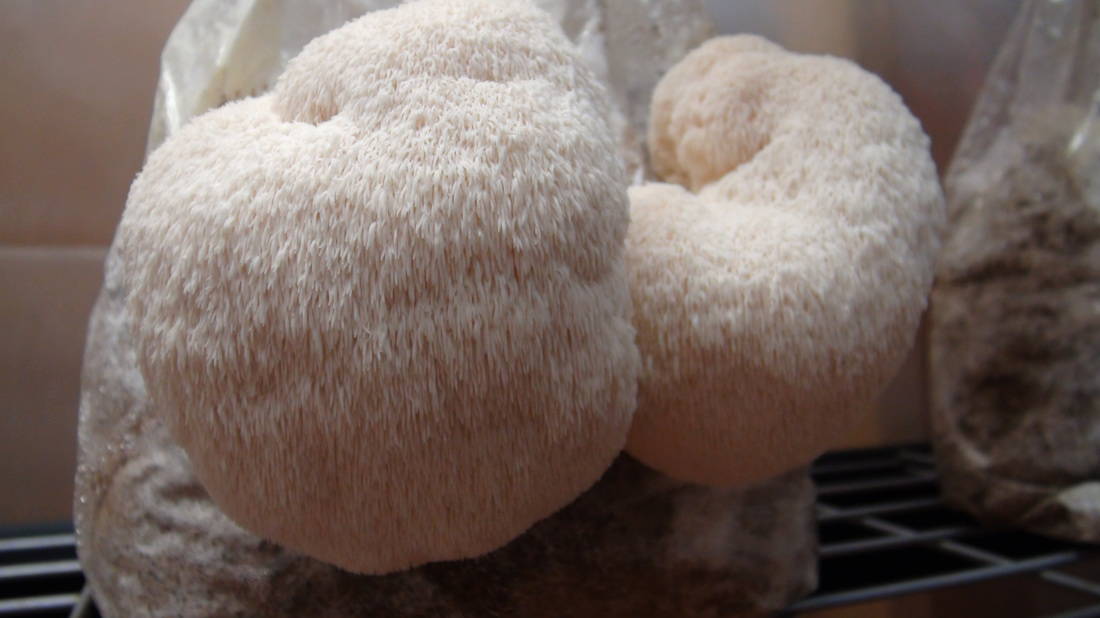
It’s hard for me to pick my favorite mushroom to grow. Aren’t they all equally great?
Maybe.
But… if I had to choose, I would say growing Lion’s Mane mushroom takes the top spot.
That’s because Lion’s Mane is not only easy and fun to grow, but also produces huge delectable fruiting bodies that can be an awesome addition to any meal. As an added bonus- it also boasts some pretty incredible health benefits.
Unfortunately, you’re not likely to find Lion’s Mane at your local grocery store- so having a fresh supply means that you’ll need to learn how to grow it indoors yourself.
Luckily, there’s lots of techniques on this site to get you started, but first, let’s take a look at what makes this mushroom so special.
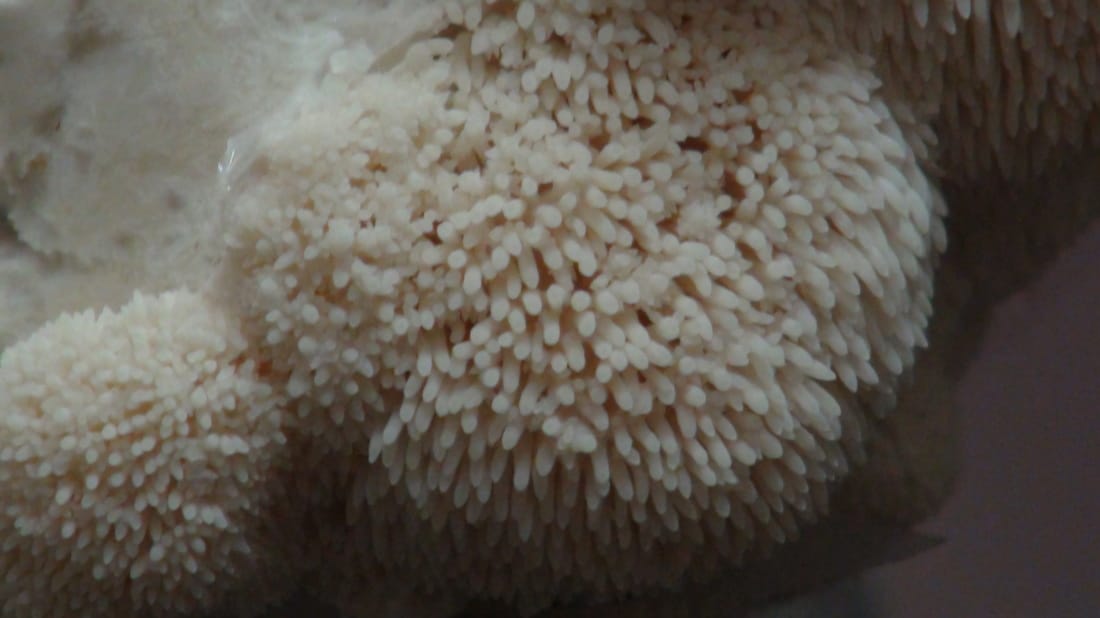
Species Description
Scientific Name: Hericium erinaceus
Lions Mane Mushroom grows in large snowball like formations. The mushroom is white, sometimes browning if the spines are damaged or with age. Individual mushrooms can be quite large, sometimes weighing over 1 lb. The spines or “teeth” start out quite small, but elongate with age.
The mushroom is spongy and sometimes semi-hollow. It is sensitive to direct spraying when growing, bruising easily.
Lions Mane Mushroom starts out as tiny spines.
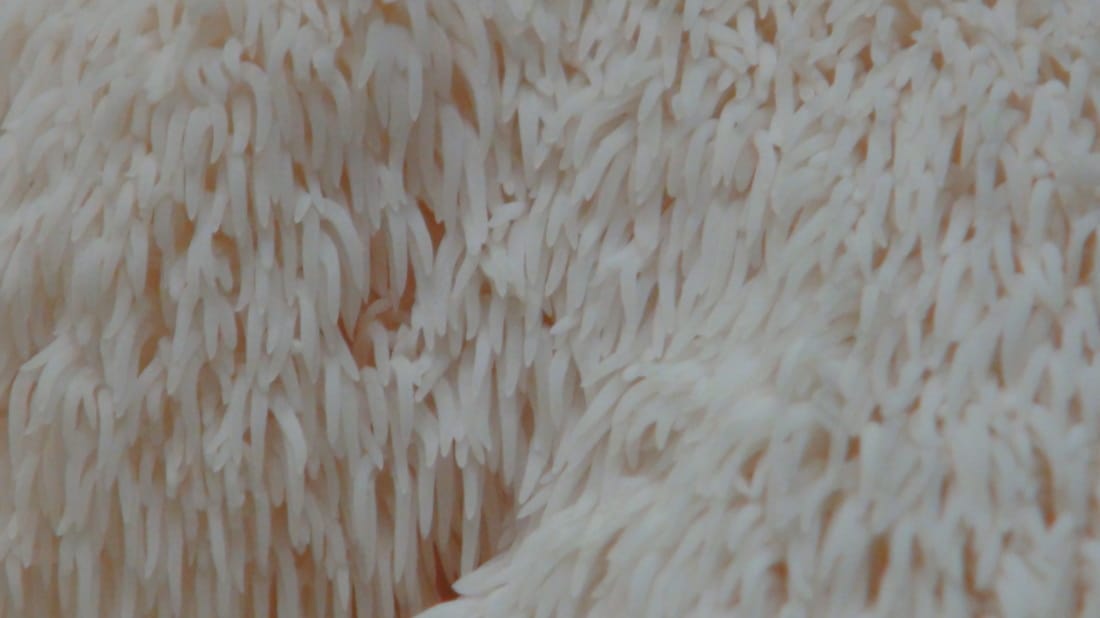
Lions Mane teeth elongate as the mushroom grows.
Natural Habitat: Lions Mane is most commonly found on dead and decaying hardwood logs, most often in the fall throughout North America.
Difficulty of Cultivation: Easy-Medium
Agar: Lions Mane is unique on Agar. It rarely grows out to the edge of the plate, but instead form little glacier like formations emanating from the initial wedge. Long teeth grow out from the wedge in all directions. The mycelium is also slow to take off initially.
Spawn Types: Grains, especially Rye grain. Watch Lions Mane grain spawn very closely, as it has the tendency to start fruiting well before full colonization. Lions Mane grain spawn needs to be shaken often to ensure full colonization of the spawn.
The mycelium can look thin and whispy, so close inspection is required. It can sometimes look like colonization is incomplete even though its fully colonized.
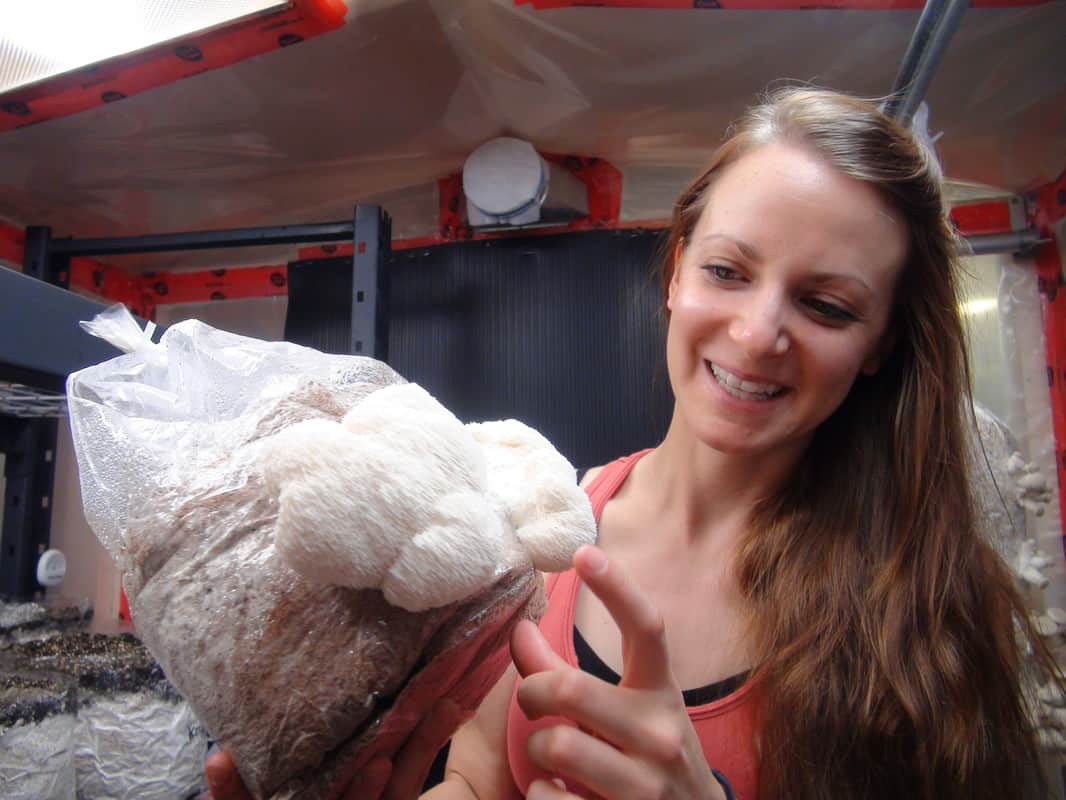
Tegan holding a bag of fruiting Lions Mane.
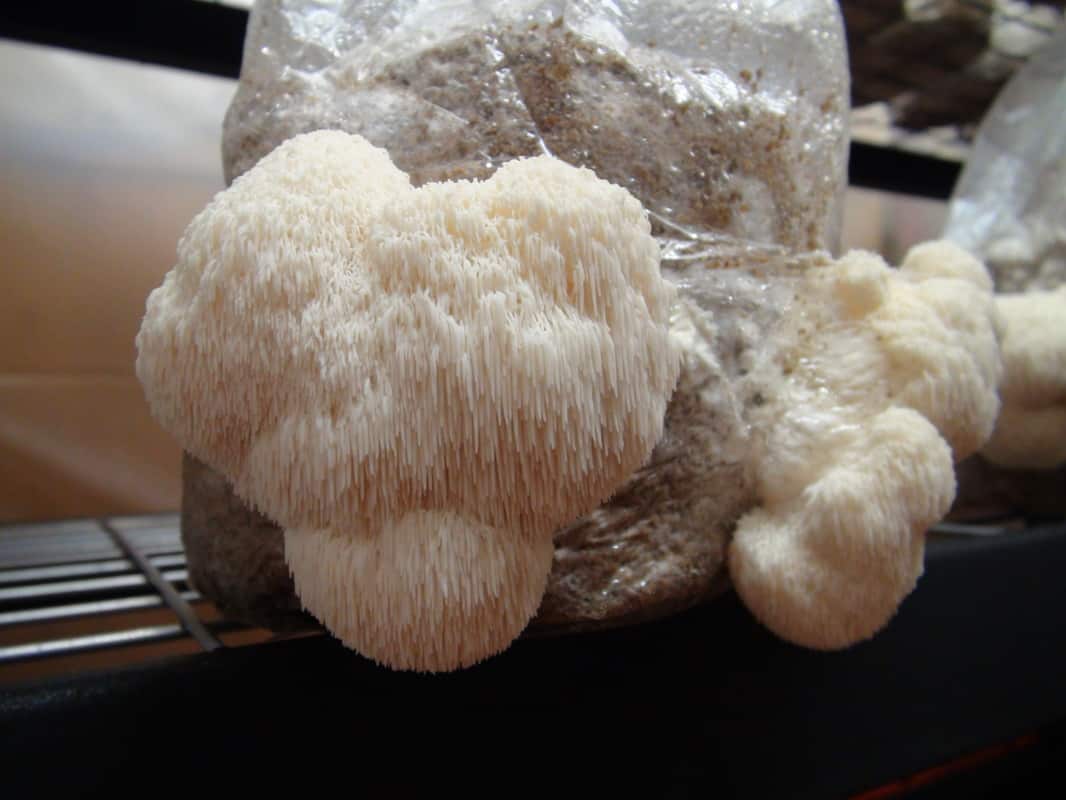
Showing the elongated spines of the Lions Mane Mushroom.
Substrate Types: Lions Mane grows best on supplemented hardwood sawdust. Supplement with wheat bran at 10-20%. Higher spawn rates are effective with Lions Mane, increasing the chances that full colonization will take place. Lion’s Mane will also grow well on the “master’s mix”.
Fruiting Containers: Use large autoclavable filter patch grow bags to create a fruiting block. Once full colonization is achieved, fruit by slicing small “x’s” in the bag at the site of primordia, or where the Lions Mane naturally starts to fruit. Do not cut off the top of the bag. More holes will cause more smaller fruit, whereas less holes will ensure fewer but larger fruit.
Yield: More than 2 lbs of Lions Mane can be harvested from a single 5 lb fruiting block over multiple flushes. Some individual fruits can weigh well over one pound.
Harvest: Harvest the Lions Mane by cutting the “snowball” off close to the bag with a sharp knife. Be very delicate with the fruit as to not damage the spines. The mushroom will store much longer in the fridge if handled delicately.
Simply leave the fruiting block in the grow room without cutting new holes in the bag. Subsequent flushes will occur, with fruits developing at the sites of previous fruits.
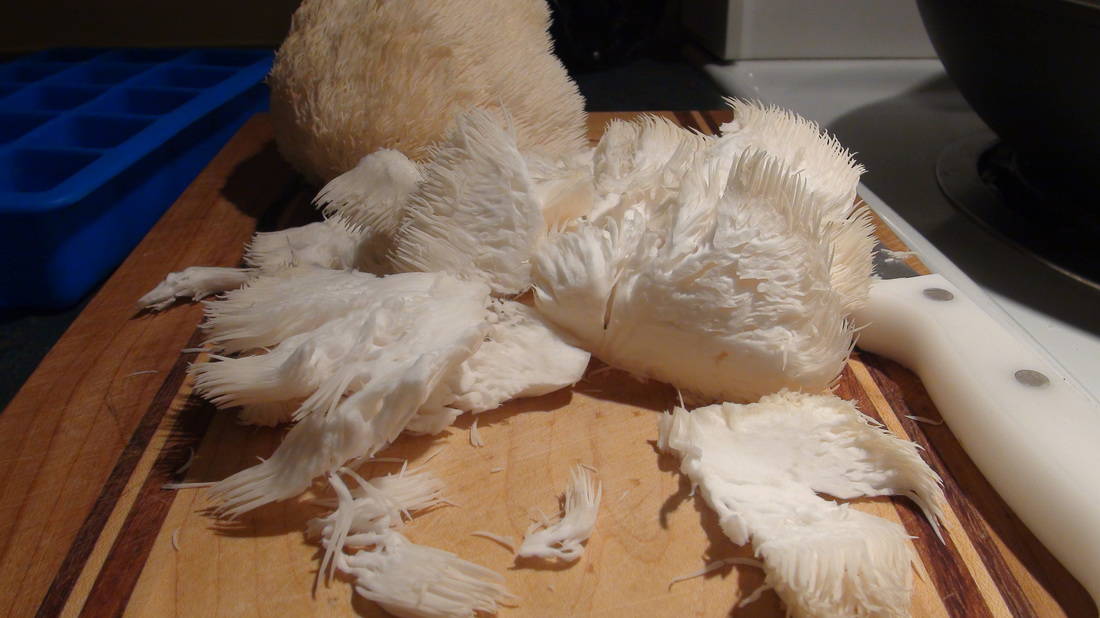
Sliced up sections of Lions Mane Ready for the Frying Pan!
Weakness: Lions Mane is sometimes difficult to achieve full colonization. Some growers have had more success with Liquid Culture techniques. The mycelium is slow to take off on agar and rarely grows out in a natural circular pattern. The mushroom bruises easily and great care must be taken during spraying of the grow room and especially during harvest. Lions Mane will last a long time in the fridge if properly handled.
Cooking: Lions Mane is a culinary treat, extremely versatile in the kitchen. It acts as a good supplement for meat in many dishes, especially chicken. It has a spongy texture that soaks up whatever flavor it is cooked in. Simply cut the mushroom lengthwise into slices and fry in a pan. Many people find Lions Mane mushroom to be a good imitator of lobster, fried in a pan and dipped in melted butter. Lions Mane mushroom is also said to have medicinal properties, and thought to increase cognitive abilities by initiating nerve growth and regeneration. It can be found in health stores.
The Specifics
Spawn Run:
Incubate at room temperature for 10-14 days. Watch closely for whispy and thin colonization, and early primordia formation. Shake Often.
Initiate Pinning:
Pinning usually starts on its own. Lower temperature to 15 deg C. Cut holes in the grow bags and place in grow room.
Fruit Development:
Temperatures between 15-20 deg C. Humidity at 90%. Ensure not to spray fruits directly when misting. Fresh air requirements are relatively low.
How To Grow Lion’s Mane Mushroom
The process for growing Lion’s Mane is quite similar to growing any other type of gourmet mushroom- although there are some slight differences to watch out for. Depending on where you are at in your mushroom growing journey, you’ll want to a suitable approach to growing at home.
By far the easiest way to grow Lion’s Mane at home it is to start with a kit. This is the best option for people who are new to the hobby.
Looking for a more authentic experience for DIY Lion’s Mane at home? If so, you could start from commercially made spawn. This requires a few more tools and a little more experience, but you’ll get substantially better results. Even better- if you really want to go down the rabbit hole, you can even make your very own spawn starting from a pure culture on agar.
Lion’s Mane Grow Kit
Mushroom growing kits are a great option for folks who are new to the hobby, or do not want to get too deep into into the art of growing mushrooms. They are basically just a fully colonized mushroom fruiting blocks. If you have a kit, most of the hard work has already been done for you.
You can buy these kits from various places online, or perhaps even at your local farmers market. I have even seen kit at the grocery store, although never for Lion’s Mane.
Once you have the block, all you need to do is to put it in a relatively humid environment and cut some “x’s” into the side of the bag. Put the block on it’s side on a plate, so that the mushrooms will fruit out the top. For humidity, place a sheet of perforated plastic over the block, making sure there is lots of free space between the block and the plastic. Lion’s Mane fruits will naturally start to form through the holes in the bag.
Mist inside the bag with a spray bottle a few times a day, and make sure to fan in lots of fresh air. To make this even better, build a small shotgun fruiting chamber.
You are likely to get 2 or 3 flushes with a kit, and depending on where you live, might not require any special environment whatsoever.
Lion’s mane will even grow pretty well in sub-par conditions, so unless you are looking for spectacular results, you don’t need to be overly concerned about the block’s environment.
I have even had Lion’s Mane blocks fruit heavily after placing them in the garage (humidity around 65% RH) and simply forgetting about them. The fruits themselves were large, with small spines, and lasted over a week in the fridge without looking any worse for wear. Talk about care-free growing!
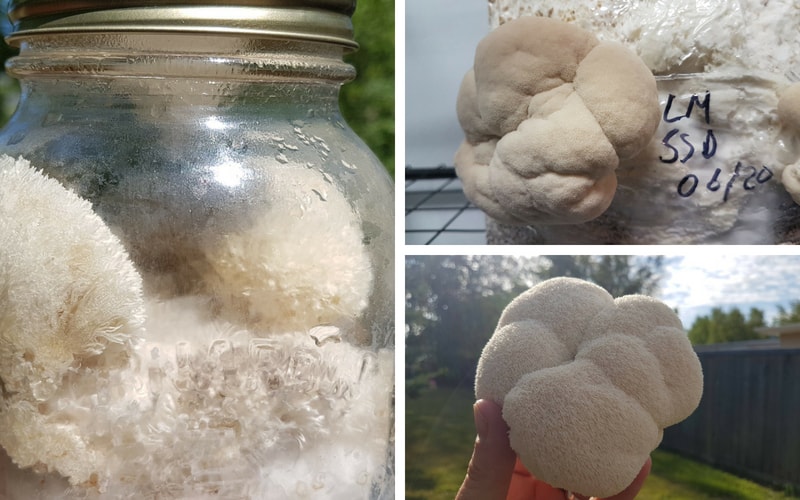
Lion’s Mane fruiting on grain spawn (way over colonized), and grown in a garage without due care and attention.
Starting From Spawn
Of course, if you have experience with mushroom cultivation, you could also just get some Lion’s Mane spawn, and add it to a suitable substrate.
Hardwood sawdust amended with bran is one of the best substrates for growing Lion’s Mane. The typical fruiting block recipe works great, and should give you a a good yield over a number of flushes.
Recently, I have also had great success growing Lion’s Mane on the Master’s Mix, a 50-50 hardwood sawdust and soy hulls that has been hydrated to 60%. Yields seem to be slightly higher, and the shelf life seems to be a little better on this substrate, although some further experimentation is still needed.
Lion’s Mane can also grow on straw, although I have not personally tried this method. (I try to avoid messy straw as much as possible!) Growing Lion’s Mane on straw might only yield great results for particular strains that have been specifically adapted to straw. For best results, you are better off just using a wood based substrate.
Add the spawn at 10-15% spawn rate to sterilized substrate in a clean environment. A laminar flow hood works best. Although lion’s Mane is reasonably resistant to contamination, all precautions should still be still be taken to protect your grow. Once inoculated, a fruiting block should be fully colonized within 2 weeks.
Lion’s Mane mycelium can be whispy and thin in places, and looks quite a bit different than something more robust like oyster or reishi. Dn’t be alarmed if the block doesn’t look fully colonized.
This mushroom fruits easily, so chances are you’ll start to see small fruits forming in the bag before you expose it to fruiting conditions. When this happens, simply bring the block to the fruiting area and cut small “x’s” where the fruits are already forming. The pins will continue to develop, eventually forming large mushrooms outside the bag.
Growing Lion’s Mane From Scratch
If you want to grow Lion’s Mane from scratch, you ‘re best to start with a culture on agar, and make your own grain spawn from there. You could also start with a liquid culture, although you are still better off to just put the liquid culture on agar for long term storage and re-use.
The process for lion’s mane is the same as other species- grow out the culture on agar, make grain spawn, add it to a bulk substrate, and fruit. As long as you have a healthy culture, you should be able to grow fresh lion’s mane anytime you want.
Lion’s Mane mycelium will last for a long time on a culture plate. In fact, I have cultures that are over 3 years old that still perform fantastically. If you want to store the plates for the long term, ensure that you keep them in the fridge. Lion’s Mane mycelium is prone to fruiting on the agar plate, forming long spines that eventually try to work their way out of the dish, leading to contamination. Keeping the culture in the fridge will prevent this from happening.
Often fruit on the grain spawn as soon as it finishes colonizing. As long as you catch it in time it won’t be a problem. You don’t even need to remove the tiny fruits- just mix it up with the rest of your grain spawn before adding it to the bulk substrate.
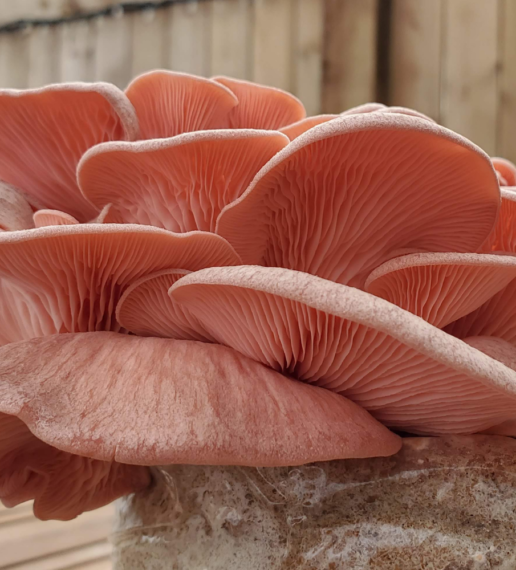
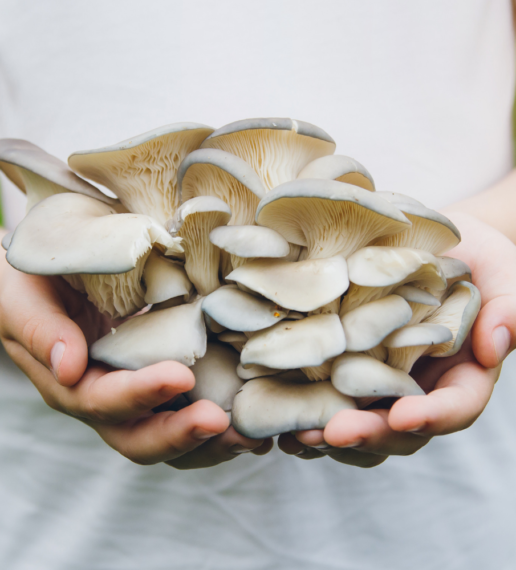
I have been having some encouraging success with this magnificient species! All bags are on their first flush and produce nice yields. However, I am unsure as to what to do bewteen flushes.
Should I simply remove the block from the greenhouse and let it sit? For how long? Wrap it in plastic and poke new holes? Cold shock again? Etc, etc. I have read so many different things on how to prepare a block for the next flush that I am at a loss.
So far the info on your site has helped us a lot, so I figured you might be of assistance.
Hey Gabriel,
Thanks for reaching out! For Lion’s Mane, I simply leave it in the grow chamber and let it sit in the same conditions. The second flush will come quite naturally, usually within a week or so. If you see new fruits developing under the plastic, you could always cut new holes in that location as well.
Happy growing!
Thank you very much. A quite simpler solution than many I have found. Keep up the good work guys
Hi there,
What did you use to start growing your lions mane? I am interested in growing my own but am not sure what brands are trustworthy.
Hi Beth! Thanks for reaching out! I originally purchased a culture of Lion’s Mane many years ago from another online retailer. I have kept that strain and use it today for growing at home. If you are interested, we also sell Lions Mane spawn, however we do not sell the culture.
What’s the difference between spawn and fruit block?
Hey Christian! You can think of spawn like the “seed” of the mushroom and fruiting block is the substrate (soil?) which eventually fruits the mushrooms. That being said, fruiting blocks can be broken up before they fruit, and be used to spawn even more substrate.
I am trying to grow Lion’s Mane in buckets of moist sawdust. I first colonized jars of grain, which seemed to go ok, then spread the mycelium into hardwood fuel pellets which had been soaked in water and rung to reasonable moisture content.
Throughout this whole process, I’ve just noticed that every stage of growth takes way longer than anyone says it should. Also, someone on r/mycology told me it was unnecessary to sterilize the fule pellets, as they were clean to begin with and the fungus doesn’t grow on sterile trees in the wild. Also, many people grow oyster mushrooms on straw that has been pasteurized at 170 degrees to allow beneficial bacteria to grow. I have 3 buckets (2gal buckets) pasteurized and 3 not pasteurized. I can see some very fine mycelium filaments growing on top, no idea how it is growing under the top layer. I’m hoping for it to fruit through holes drilled in the side of the bucket, which are covered by with duct tape. Duct tape has slits cut with a knife.
Is this going to work? Can I make these things grown any faster? Also, is there any better way to grow with buckets, or is it simply impossible?
Hey Jack, thanks for reaching out! I think your method seems fine. If you aren’t adding any supplementation (such as wheat bran) then you should be OK without full sterilization. I have grown oysters on straight pasteurized wood chips before in a 5 gallon bucket with awesome results. Lions Mane appears to grow slower than many other types of mycelium so don’t worry too much. Also, sometimes it is really whispy and hard to see, so you might be further along then you think.
All the best,
Tony
Hey Jack I’m starting this adventure with lions mane and buckets and was wondering how it went?
Just trying my hand at Lion’s Mane.
Starting in a pint jar of sterilized barley.
Starting to see what I believe to be mycelium. The color is greyish and wispy. Is this correct for Lion’s Mane?
Sounds about right! Lions Mane is very thin, sometimes it looks like there is no mycelium at all in places, but it is still pinning heavily. You’ll know pretty quick!
Happy growing!
Hi! I’m about to get some spawn plugs for lion’s mane, and was wondering if I colonize it on rye berries, then add to saw dust at 20%(?) would that make my sawdust supplemented?
Yes and no. Technically it is supplemented because the grain has a lot of nutrition- but since it is already colonized when you are adding it to sawdust, then the block won’t follow the typical “supplemented” sawdust recipe. Hope that makes sense!
Tony, I have 2.5 lbs each oyster, shiitake and lions on the way from you. Going to grow on oak chainsaw shavings. The shavings are kind of curly and I’m concerned about how tightly to pack them, supplement rates , if any needed, and how much of your grain spawn to add per 5 lb bag.
THANK YOU! Alex. First time grower
Hi there! Growing lions mane and all is going very well so far, except that my spines aren’t elongating the way they should.the spines are growing, but aren’t drooping.they just stand straight up all over the place. They’ve been fruiting now for about 2.5 weeks, and I’m just not sure if that’s normal, or are they lacking something they might need? 23 degrees and about 80 to 85 percent humidity, spraying the chamber about 3x/day in a fine mist.any advice would help a lot! Thanks
Joe
Hey Joe!
My guess would be that you don’t have enough FAE (fresh air exchange). Try getting more air into your chamber while keeping the humidity up.
First time fruiting Lions mane. Substrate is oak shavings supplemented with oat bran. Noc’d up 5/12. Looks like it never fully colonized. Used grain spawn from fresh cap. 92^ humidity full chamber fae every 50 minuets. Temp is hovering 78-80. The bigger one pinned 5 days ago. So seems like a slow grow. Any input?
Hi Joe,
So a friend just dropped a couple of big bags of Lions mane, Chicken of the woods and something he called Sheep head mushrooms. It’s awesome and great and I’ve found quite a few recipes on-line. But I don’t know what to do with the bounty in the meantime.
Could you give me some pointers on how to wash/store and how long will it keep?
Hey Laura! Lucky you. The sheeps head is Maitake, most likely, that is a common name. Best would be to keep them in a paper bag or paper towel in the fridge. Enjoy!
awesome products, will be ordering from you
Great to hear! Thanks for checking us out 🙂
Hi Tony,
So my mom and I were just gifted a set of grow bags of pink oyster and lions mane! I tried to follow the instructions included with the mushrooms but noticed that the lions mane had already started to fruit within the unopened bag( or it at least looked like it). I ended up cutting the top of the bag off instead of folding the top down and cutting ‘x’s into the sides because I didn’t want to squish what was already growing. Granted, we’ve yet to see results as this was done recently but for future reference, would you have just squished down the bag? Or was cutting the top off, essentially leaving the entire block exposed, an okay thing to do in this case? Thanks for your advice!
That sounds awesome! In general, it’s OK if they start fruiting inside the bag. You can always cut little “x’s” where the fruits have already grown… but for Lion’s Mane, pretty much anywhere you cut the “x’s” the fruits will find a way to get through.
Hello,
What is the required pH for the growing media(for lions mane) ? Does anyone has an expierence with peat substrates? Thank you.
Hey Tony,
I had a question I hope you could help with. I am doing my own Lion’s Mane grow at home, but my fruits are looking a bit weird. They have never developed the hanging icicle like things hanging down, there is a mix of more root like growths or puffy areas. I am certain there is no mold or contamination, but they have never developed the iciclel like parts. I know my air exchange could be lacking, but have you ever seen or heard of this? Thank you!
Hey Matthew, as you mentioned, air exchange is the most likely candidate… that can definitely cause weird looking fruits…. but it could also be a strain issue. I would try first getting more fresh air, and if that doesn’t work, consider trying a more consistent strain.
Hello!
I started growing lions mane with a grow kit in a plastic bag. My first lions mane growth has a bacterial blotch. Can I remove and try for a second flush?
Thanks Tony!!
Torey
Just the fruiting body had some bacterial blotch? If that is the case you could certainly try again. As long as there is no contamination on the block itself, it would be worth a second try.
Hi, great guide thank you very much for taking the time to write it! I’ll be starting from scratch to try and grow some.
Quick question, when you mention “Add the spawn at 10-15% spawn rate to sterilized substrate in a clean environment.”, I’m unfamiliar with “spawn rate”, is this saying to add the spawn to the substrate when the spawn is only 10-15% colonized?
Also, when storing a culture long term, is a agar slant preferred over a petri dish? I will be starting with a liquid culture, and would like to store some right away to be safe. I have some agar petri dishes already made up so I could put some on those but I know with other species these didn’t last more than a few months as the mycelium began to grow up the edges and eventually began fruiting as well, although I didn’t store them in a fridge. I would love to hear what you store yours on where you’re able to keep it going for years as mentioned above.
Thanks!
Glad you like it!
Spawn rate simply means how much spawn to use. So for a 5 lb block, a 10% spawn rate would be 0.5 lbs (10% of 5). The spawn should be fully colonized when adding to the substrate.
Yes, agar slant is preferred for long term storage. The culture is more likely to live longer in a slant. I have had some cultures for years!
What type of agar medium is used for tissue culture? Just NB?
hello. what is a good temperature to grow lions mane on agar? I think i have the temperature set to high.
Thanks so much for this helpful article! I’m having a hard time finding guidance on what to do when my fruiting block broke up into 3-5 chunks inside the bag during the shipping process. I tried to squish it together but it didn’t really work. I’m wondering if you had any advice or tips here, or if it even makes a difference?
Hi there, greeting from Malaysia. We are thinking to try out some grourmet mushroom growing here. Please hit me a reply if you do provide shipping for the spawn culture. Cheers.
Hey what’s going on tony you rock btw, I did your bucket Tek with Aspen chips and it did work awesome! What’s the difference in using supplemented hardwood compared to not? And do you think lions mane would work if you have to keep breaking up so it finishes colonizing?
Our Mushroom household loves your expertise! What is you opinion when lions mane turns brown and spongy after about 7 days. It didn’t look fully developed and didn’t have shag but the fruit was porous and watery feeling. They are in a mini greenhouse and are at 80% humidity.
Hey there! Glad you like the site 🙂 Interesting, maybe they got too wet? Do you spray them directly?
hai tony ,im cultivate oyster mushroom,very much interested to grow lion mane,iam from india.our temperture 28 c ,,can u advice me to cultivate lion mane
Hi Tony,
Thanks for the interesting article.
Do you know how you can transform the full grown lions mane into powder (for consumption)?
Many thanks.
Hey Elmer! Yes, you first need to dry the fruiting body, and then you can grind it into a powder. Where I live, it is easy to just dry them on a rack or have them sit out on a counter (it is dry here) but you may need to use a oven or dehydrator. Hope that helps!
Thanks Tony. You slice it first or you let the whole body intact for drying?
How can you tell it is dry enough?
How does lions mane do in buckets? And how large should i make the holes?
How do you water mushrooms?
Hi Tony I recently started a lions mane spawn Jar and I noticed that a growth that looks like mycellium is happening but the growth has a greenish grey tint to it. My substrate is supplemented HWFP with 20% coffe grounds mixed in. I am wondering if that is an effect of white mycellium growing against a very dark substrate. Since I was told that Lions mane may grow wispy maybe it isn’t contamination. What do you think?
Also I am having a hard time fruiting button mushrooms, I am using a combination of top soil and Manure compost to colonize and after colonization I case with peat moss and continue to spray 2x a day.
Hi Tony,
I am interested in farming Lion’s Mane and Maitake on a small scale. Could you inform me about the yield per 1000 sq.m. per year of each? Would really appreciate the help.
Thanks.
Hi!
I was wondering how long you can keep grainspawn for? Can you just keep spreading inoculated grainspawn among sterilised rye grain?